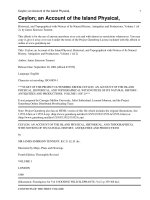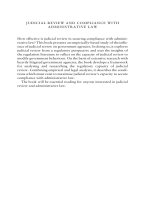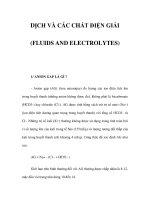2010 fluids and electrolytes with clinical application
Bạn đang xem bản rút gọn của tài liệu. Xem và tải ngay bản đầy đủ của tài liệu tại đây (39.5 MB, 577 trang )
Fluids and Electrolytes
with Clinical Applications
A Programmed Approach
8th Edition
Joyce LeFever Kee, MS, RN
Associate Professor Emerita
College of Health Sciences
University of Delaware
Newark, Delaware
Betty J. Paulanka, EdD, RN
Dean and Professor
College of Health Sciences
University of Delaware
Newark, Delaware
Carolee Polek, PhD, RN
Associate Professor of Nursing
College of Health Sciences
University of Delaware
Newark, Delaware
Australia • Canada • Mexico • Singapore • Spain • United Kingdom • United States
Fluids and Electrolytes with Clinical
Applications: A Programmed Approach,
8th Edition
Joyce LeFever Kee, Betty J. Paulanka,
and Carolee Polek
Vice President, Career and Professional
Editorial: Dave Garza
Director of Learning Solutions:
Matthew Kane
Executive Editor: Steven Helba
Managing Editor: Marah Bellegarde
Senior Product Manager: Juliet Steiner
Editorial Assistant: Meaghan O’Brien
Vice President, Career and Professional
Marketing: Jennifer McAvey
© 1971, 1978, 1982, 1986, 1994, 2000, 2004, 2010 Delmar,
Cengage Learning
ALL RIGHTS RESERVED. No part of this work covered by the copyright
herein may be reproduced, transmitted, stored, or used in any form or by
any means graphic, electronic, or mechanical, including but not limited to
photocopying, recording, scanning, digitizing, taping, Web distribution,
information networks, or information storage and retrieval systems, except
as permitted under Section 107 or 108 of the 1976 United States
Copyright Act, without the prior written permission of the publisher.
For product information and technology assistance, contact us at
Professional & Career Group Customer Support, 1-800-648-7450
For permission to use material from this text or product,
submit all requests online at cengage.com/permissions.
Further permissions questions can be e-mailed to
Marketing Director: Wendy Mapstone
Library of Congress Control Number: 2008931928
Marketing Manager: Michele McTighe
ISBN-13: 978-1-4354-5367-8
Marketing Coordinator: Scott Chrysler
Production Director: Carolyn Miller
ISBN-10: 1-4354-5367-0
Production Manager: Andrew Crouth
Content Project Manager:
Andrea Majot
Senior Art Director: Jack Pendleton
Delmar
5 Maxwell Drive
Clifton Park, NY 12065-2919
USA
Cengage Learning is a leading provider of customized learning solutions with
office locations around the globe, including Singapore, the United Kingdom,
Australia, Mexico, Brazil, and Japan. Locate your local office at:
international.cengage.com/region
Cengage Learning products are represented in Canada by
Nelson Education, Ltd.
For your life long learning solutions, visit delmar.cengage.com
Visit our corporate website at cengage.com.
Notice to the Reader
Publisher does not warrant or guarantee any of the products described herein or perform any independent analysis in connection with any of the product
information contained herein. Publisher does not assume, and expressly disclaims, any obligation to obtain and include information other than that provided to it
by the manufacturer. The reader is expressly warned to consider and adopt all safety precautions that might be indicated by the activities described herein and to
avoid all potential hazards. By following the instructions contained herein, the reader willingly assumes all risks in connection with such instructions. The publisher
makes no representations or warranties of any kind, including but not limited to, the warranties of fitness for particular purpose or merchantability, nor are any
such representations implied with respect to the material set forth herein, and the publisher takes no responsibility with respect to such material. The publisher
shall not be liable for any special, consequential, or exemplary damages resulting, in whole or part, from the readers’ use of, or reliance upon, this material.
Printed in United States of America
1 2 3 4 5 X X 11 10 09
Dedication
To
The Faculty, Staff, and Alumni of the School of Nursing in
the University of Delaware’s College of Health Sciences for
their commitment to excellence in nursing education.
To
Joyce Kee for her continued commitment to nursing
publications and support for faculty scholarship
through authorship in her books.
iii
Licensed to: iChapters User
Contents
Preface / vi
Acknowledgments / viii
Contributors and Consultants / ix
Reviewers / x
Helpful Suggestions from the Authors / xi
UNIT 1
BODY FLUID AND ITS FUNCTION / 1
Chapter 1: Body Fluid, Its Function and Movement / 3
UNIT 2
FLUIDS AND THEIR INFLUENCE
ON THE BODY / 28
Chapter 2: Extracellular Fluid Volume Deficit (ECFVD) / 30
Chapter 3: Extracellular Fluid Volume Excess (ECFVE) / 49
Chapter 4: Extracellular Fluid Volume Shift (ECFVS) / 68
Chapter 5: Intracellular Fluid Volume Excess (ICFVE) / 75
UNIT 3
ELECTROLYTES AND THEIR INFLUENCE
ON THE BODY / 89
Chapter 6: Potassium Imbalances / 98
Chapter 7: Sodium and Chloride Imbalances / 137
Chapter 8: Calcium Imbalances / 166
iv
Copyright 2009 Cengage Learning. All Rights Reserved. May not be copied, scanned, or duplicated, in whole or in part.
Licensed to: iChapters User
Contents
Chapter 9: Magnesium Imbalances / 198
Chapter 10: Phosphorus Imbalances / 220
UNIT 4
ACID-BASE BALANCE AND IMBALANCE / 239
Chapter 11: Regulatory Mechanisms for pH Control / 245
Chapter 12: Determination of Acid-Base Imbalances / 254
Chapter 13: Metabolic Acidosis and Alkalosis / 262
Chapter 14: Respiratory Acidosis and Alkalosis /278
UNIT 5
CLINICAL SITUATIONS: FLUID, ELECTROLYTES,
AND ACID-BASE IMBALANCES / 295
Chapter 15: Fluid Problems of Infants and Children / 297
Chapter 16: Fluid Problems of the Older Adult / 343
Chapter 17: Trauma and Shock / 363
Chapter 18: Gastrointestinal (GI) Surgery with Fluid
and Electrolyte Imbalances / 406
Chapter 19: Renal Failure: Hemodialysis, Peritoneal
Dialysis, and Continuous Renal Replacement
Therapy / 427
Chapter 20: Chronic Diseases with Fluid and Electrolyte
Imbalances / 463
Appendix A: Common Laboratory Tests and Values for Adults
and Children / 516
Appendix B: Foods Rich in Potassium, Sodium, Calcium, Magnesium, Chloride, and Phosphorus / 532
Appendix C: The Joint Commission’s (TJC) List of Accepted
Abbreviations / 535
Glossary / 539
References/Bibliography / 547
Index / 553
Copyright 2009 Cengage Learning. All Rights Reserved. May not be copied, scanned, or duplicated, in whole or in part.
● v
Licensed to: iChapters User
Preface
Nurses and health care professionals are involved continually in the
assessment of fluid and electrolyte imbalance. Medical advances and new
treatment modalities have increased the importance of a strong background
in the physiologic concepts associated with these imbalances. Additionally,
the expanded role of nurses in the community requires them to function
more autonomously in assisting patients to control fluid and electrolyte imbalances. Every seriously or chronically ill person is likely to develop one
or more of these imbalances, and the very young and the very old are especially vulnerable to changes in fluid and electrolyte balance. Even those
who are only moderately ill are at high risk for these imbalances. Multiple
health care providers are responsible for maintaining homeostasis of fluid
and electrolyte balance when caring for patients. After completing this
book, the learner should understand more fully the effects of fluid, electrolyte, and acid-base balance and imbalance on the body as they occur in
many clinical health problems across the life span.
New to This Edition
The eighth edition of this programmed text, Fluids and Electrolytes with
Clinical Applications, has been completely updated to meet the current assessment, management, and clinical interventions recommended for fluid,
electrolyte, and acid-base imbalances related to common, recurring clinical
health problems. The chapters include learning outcomes, introduction,
pathophysiology, etiology, clinical manifestations, clinical management,
clinical applications, clinical considerations, case studies, and nursing diagnoses with clinical interventions, appropriate rationale, and evaluation
outcomes. This new edition also includes:
●
●
Increased emphasis on evaluation and outcomes for each chapter helps
to clarify expected outcomes and identify best practices.
Extensive revisions have been made throughout the book. Case studies
have eliminated patient names to emphasize new HIPPA regulations and
promote a model of patient privacy when discussing clinical patients and
situations. In addition, Web sites have been added at the end of many
chapters as another resource for learning fluid and electrolyte content.
vi
Copyright 2009 Cengage Learning. All Rights Reserved. May not be copied, scanned, or duplicated, in whole or in part.
Licensed to: iChapters User
Preface
●
●
●
●
●
●
●
● vii
Chapter 12 has been completely rewritten to simplify concepts related
to Acid-Base Imbalances.
Chapter 18, Gastrointestinal (GI) Surgery with Fluid and Electrolyte Imbalances, has been expanded to include content on bariatric surgery.
The content related to COPD in Chapter 20 has been completely revised
and updated.
The glossary has been expanded and updated with new and revised
definitions.
The References/Bibliography has been completely updated with many
new sources of reference.
Three new appendices have been added; a table of common lab studies
for fluid and electrolyte imbalances, a table of Foods Rich in Potassium,
Sodium, Calcium, Magnesium, Chloride, and Phosphorus, and a copy of
the Joint Commission’s recommendations for abbreviations.
Many of the numerous tables and figures have been updated to current
standards for accurate references to pertinent information.
The content of this book has been geared to three levels of learning
among the healthcare professions. First, it is intended for beginning students who have had some background in the biological sciences or who
have completed an anatomy and physiology course. Second, it is for students who have a sufficient background in the biological sciences, chemistry, and physics but who need to learn about specific clinical health
problems that cause fluid and electrolyte imbalances. Many of these students might wish to review the entire text to reinforce their previous knowledge and/or practice their skills in providing accurate nursing assessments
and interventions. Finally, this book is intended to aid graduate nurses who
wish to review and improve their knowledge of fluid and electrolyte
changes in order to assess their patients’ needs and enhance the quality of
patient care. Summary charts have been included as quick reference
sources for working professional.
What Is a Programmed Approach?
The programmed approach is a self-instructional method of learning that
helps the instructor to use class time more efficiently, and enables students
to work at their own pace while learning the principles, concepts, and application of fluids and electrolytes.
Throughout, an asterisk (*) on an answer line indicates a multiple-word
answer. The meanings for the following symbols are: ↑ increased, ↓ decreased, Ͼ greater than, Ͻ less than. A dagger (†) in tables indicates the
most common signs and symptoms. A glossary covers words and terms
used throughout the text. It should be useful to the student who had minimal preparation in the biological sciences.
Joyce LeFever Kee, MS, RN
Betty J. Paulanka, EdD, RN
Carolee Polek, PhD, RN
vii
Copyright 2009 Cengage Learning. All Rights Reserved. May not be copied, scanned, or duplicated, in whole or in part.
Licensed to: iChapters User
Acknowledgments
For the eighth edition, we wish to extend our deepest appreciation to
Faculty Ingrid Pretzer-Aboff, Judy Herrman, Carolee Polek, William Rose,
Kathy Schell, Gail Wade, Erlinda Wheeler and Alumni and Linda Laskowski
Jones in the College of Health Sciences at the University of Delaware for
their contributions and assistance.
We especially wish to thank Barbara Vogt in the Dean’s Office of the College of Health Sciences at the University of Delaware for her work in coordinating correspondence and typing materials.
We also offer our thanks to our editors Steven Helba and Juliet Steiner
at Delmar, Cengage Learning for their helpful suggestions and assistance
with this revision.
Joyce LeFever Kee
Betty J. Paulanka
Carolee Polek
viii
Copyright 2009 Cengage Learning. All Rights Reserved. May not be copied, scanned, or duplicated, in whole or in part.
Licensed to: iChapters User
Contributors and Consultants
Pretzer-Aboff, RN
Associate Professor
College of Health Sciences
University of Delaware
Newark, Delaware
Kathleen Schell, DNSc, RN
Assistant Professor
College of Health Sciences
University of Delaware
Newark, Delaware
Judith Herrman, PhD, RN, ANP
Associate Professor/Undergraduate
Clinical Coordinator
College of Health Sciences
University of Delaware
Newark, Delaware
Gail Wade, DNSc, RN
Associate Professor
College of Health Sciences
University of Delaware
Newark, Delaware
Linda Laskowski-Jones, RN, MS, CCRN,
CEN
Vice President: Trauma, Emergency
Medicine and Aero Medical Services
Christiana Care Health Systems
Wilmington, Delaware
Erlinda Wheeler, DNS, RN
Associate Professor
College of Health Sciences
University of Delaware
Newark, Delaware
William C. Rose, PhD
Assistant Professor
College of Health Sciences
University of Delaware
Newark, Delaware
ix
Copyright 2009 Cengage Learning. All Rights Reserved. May not be copied, scanned, or duplicated, in whole or in part.
Licensed to: iChapters User
Reviewers
Deb Aucoin-Ratcliff, RN, DNP
American River College
Sacramento, California
Vicki Bingham, PhD, RN
Chair of Academic Programs and
Assistant Professor of Nursing
School of Nursing
Delta State University
Cleveland, Mississippi
Doreen DeAngelis, MSN, RN
Nursing Instructor
Penn State Fayette, The Eberly Campus
Uniontown, Pennsylvania
Deborah J. Marshall, MSN, RN
Associate Professor, Nursing
Palm Beach Community College
Lake Worth, Florida
Deborah A. Raines, PhD, RN
Professor
Christine E. Lynn College of Nursing
Florida Atlantic University
Boca Raton, Florida
Barbara Scheirer RN, MSN
Assistant Professor
School of Nursing
Grambling State University
Grambling, Louisiana
Diann S. Slade, MSN, RN
Instructor
College of Pharmacy, Nursing, and
Allied Health Sciences
Howard University
Washington, D.C.
x
Copyright 2009 Cengage Learning. All Rights Reserved. May not be copied, scanned, or duplicated, in whole or in part.
Licensed to: iChapters User
Helpful Suggestions
from the Authors
To the Student
Many students believe that the subject of fluids and electrolytes is very
difficult to comprehend. This programmed book provides you with important data on fluids and electrolytes from various points of view. If you apply
this material to clinical problems and previous and present experiences, it
is not so difficult to understand and retain.
By taking easy steps provided in this book, you can proceed through the
chapters more quickly than you might expect. This book is written using a
self-instruction format that allows you to proceed at your own pace. Each
step is a learning process. A better quality of learning occurs when you either complete a chapter at a time or spend a minimum of two hours at one
sitting. Never end the study period without at least completing all questions related to a single topic.
It is helpful to begin each study session with the final questions from
the previous material; this enables you to check your retention of material
that was presented previously. The case study reviews in each chapter give
immediate reinforcement of the data learned. The assessment factors, nursing diagnoses, and interventions should be useful when applying fluid,
electrolyte, and acid-base concepts in various clinical settings. The clinical
assessment tool is useful for determining fluid, electrolyte, and acid-base
balance and imbalance. A glossary is included to assist you with words and
terms used throughout the text.
Study each diagram and table before proceeding to the questions. If you
make mistakes in the program, you need not be concerned so long as you
rectify the mistakes. This learning modality and the content in this book
should increase your knowledge and understanding of fluids and electrolytes. This model of learning can be a great asset for applying this
knowledge to your clinical practicum experiences.
xi
Copyright 2009 Cengage Learning. All Rights Reserved. May not be copied, scanned, or duplicated, in whole or in part.
xii ● Helpful Suggestions from the Authors
To the Instructor
Class time is frequently spent on reviewing material or presenting new
material that can easily be given through programmed (learning) instruction.
This method of instruction enables the instructor to minimize the time spent
in lecture on fluids and electrolytes, thus devoting more time to clinical discussions and/or a seminar format to enhance the students’ understanding of
fluid and electrolyte imbalance by active class participation.
You may find it helpful to cover the material in this book by one of three
ways: (1) assigning the students a chapter at a time, (2) assigning a unit for
the students to complete by a certain date, or (3) assigning the students a
given length of time to complete the entire text and having them present
material using their clinical experiences.
Joyce LeFever Kee
Betty J. Paulanka
Carolee Polek
Copyright 2009 Cengage Learning. All Rights Reserved. May not be copied, scanned, or duplicated, in whole or in part.
Licensed to: iChapters User
U
UN
NIIT
T
BODY FLUID
AND ITS FUNCTION
I
LEARNING OUTCOMES
Upon completion of this unit, the reader will be able to:
● Compare the percentage of water found in the body
of the average adult, newborn infant, and embryo.
● Identify the three compartments (spaces) where
water is distributed in the body.
● Identify the two classifications of body fluids and
their percentages.
● Describe five functions of body fluids.
● Define homeostasis in terms of its role in maintaining body fluid equilibrium.
● Describe how the body loses and maintains body
fluid.
● Define the following homeostatic mechanisms: osmotic pressure, oncotic pressure, semipermeable
membranes, selectively permeable membranes, osmol, and osmolality.
● Describe the effects of the above homeostatic mechanisms on the movement of body fluid.
● Describe four measurable pressures that determine
the flow of fluid between the vessels and tissues in
terms of their effects on the exchange of fluid.
● Describe the concept of a pressure gradient.
● Explain the significance in colloid osmotic (oncotic)
and hydrostatic pressure gradients.
● Discuss the body’s regulators of fluid balance.
● Describe isotonic (iso-osmolar), hypotonic (hypoosmolar), and hypertonic (hyperosmolar) solutions
in terms of their effects on body cells.
● Discuss the relationship between milligrams and
milliequivalents and the significance of this relationship in the body.
1
Copyright 2009 Cengage Learning. All Rights Reserved. May not be copied, scanned, or duplicated, in whole or in part.
2 ● Unit I Body Fluid and Its Function
●
●
Develop select nursing diagnoses appropriate for
patients experiencing fluid imbalances.
Describe the effects of selected fluid changes on the observable symptoms of patients in your clinical area.
INTRODUCTION
The human body is a complex machine that contains hundreds of bones and the most sophisticated interaction of
systems of any structure on earth. Yet, the substance that is
basic to the very existence of the body is the simplest substance known—water. In fact, it makes up almost two-thirds
of an adult’s body weight.
The body is not static; it is alive, and solid particles
within its framework are able to move into and out of cells
and systems, and even into and out of the body, only because there is water.
The basis of all fluids is water, and as long as the quantity and composition of body fluids are within the normal
range, we just take it for granted and enjoy being healthy.
But if the water content of the body for some reason departs from this range, the whole delicate balance of body
systems is disrupted, and disease can find an easy target.
An asterisk (*) on an answer line indicates a multipleword answer. The meanings for the following symbols are:
↑ increased, ↓ decreased, Ͼ greater than, Ͻ less than.
Copyright 2009 Cengage Learning. All Rights Reserved. May not be copied, scanned, or duplicated, in whole or in part.
Licensed to: iChapters User
CHAPTER
Body Fluid, Its Function
and Movement
1
INTRODUCTION
The greatest single constituent of the body is water.
Body water movement and distribution are influenced by fluid intake, fluid pressures, and osmolality of the body fluid.
In this chapter, distribution of body fluids, fluid
compartments, functions of body fluid, intake and
output for homeostasis, definitions, fluid pressures, regulators of body fluid, and osmolality of
body fluid and solutions are discussed. Also included are a case study review, assessment factors,
diagnoses, interventions, and evaluation/outcome
process.
3
Copyright 2009 Cengage Learning. All Rights Reserved. May not be copied, scanned, or duplicated, in whole or in part.
Licensed to: iChapters User
4 ● Unit I Body Fluid and Its Function
ANSWER COLUMN
1.
The greatest single constituent of the body is water, which
represents about 60% of the total body weight in the average
adult, 45–55% of the older adult, 70–80% of a newborn infant,
and 97% of the early human embryo.
Label the following drawings with the proper percentage of
water to body weight.
Embryo
1.
2.
a. 97%; b. 70–80%; c. 60%;
d. 45–55%
embryo, older adult
a.__________
Adult
c.__________
Newborn
Older adult
b.__________
d.__________
2.
Which has the highest percentage of water in relation to body
weight (adult, newborn infant, embryo, older adult)?
Which has the lowest?
Copyright 2009 Cengage Learning. All Rights Reserved. May not be copied, scanned, or duplicated, in whole or in part.
Licensed to: iChapters User
Chapter 1 Body Fluid, Its Function and Movement
3.
4.
Infants have a larger
body surface area in
relation to their weight,
so extra water may act as
a cushion against injury.
person weighing
125 pounds (lean)
● 5
3.
Speculate why the early human embryo and the infant have a
higher proportion of water to body weight than the adult.
*
4.
The percentage of body water varies with the amount of body
fat. Because body fat is essentially free of water, the leaner the
individual, the greater the proportion of water in total body
weight. Water is retained in muscle.
Who has more water as body weight, a person weighing 225
pounds or a lean person weighing 125 pounds?
FLUID COMPARTMENTS
5.
Body water is distributed among three types of “compartments”:
cells, blood vessels, and tissue spaces between blood vessels
and cells that are separated by membranes.
Label the three compartments where body water (fluid) is
found.
a.
b.*
5.
a. cell; b. tissue space;
c. blood vessel
c.*
Copyright 2009 Cengage Learning. All Rights Reserved. May not be copied, scanned, or duplicated, in whole or in part.
Licensed to: iChapters User
6 ● Unit I Body Fluid and Its Function
6.
The term for the water (fluid) in each type of “compartment” is
as follows:
1. In the cell—intracellular fluid or cellular fluid
2. In the blood vessels—intravascular fluid
3. In tissue spaces between blood vessels and cells—
interstitial fluid
Label the diagram with the proper terms for body water in
each of the three compartments.
6.
a. intracellular or cellular
b. interstitial;
c. intravascular
a.
Water
(fluid)
b.
Water
(fluid)
c.
Water
(fluid)
7.
7.
8.
intracellular;
extracellular
60; 40; 20
Fluid within the cell is classified as intracellular fluid, whereas
intravascular fluid and interstitial fluid are classified as
extracellular fluid.
The area within the cell is called the
space, whereas
the tissue spaces between blood vessels and cells and the area
within blood vessels are known as the
space.
8.
Approximately two-thirds of the body fluid is contained in the
intracellular compartment.
We have already said that the total body weight in the
adult body is
% water; therefore, intracellular fluid
must represent
% of the total body weight, and
extracellular fluid represents
% of the total body
weight.
Copyright 2009 Cengage Learning. All Rights Reserved. May not be copied, scanned, or duplicated, in whole or in part.
Licensed to: iChapters User
Chapter 1 Body Fluid, Its Function and Movement
9. interstitial fluid
10. 20; 15; 5
● 7
9.
If one-fourth of the extracellular fluid is intravascular fluid,
.
then three-fourths of extracellular fluid is *
10.
Therefore, extracellular fluid represents
% of the
total body weight. Interstitial fluid represents
% of
total body weight and intravascular fluid represents
% of total body weight.
FUNCTIONS OF BODY WATER
The body is unable to maintain a healthy state without water.
Five main functions of body water are listed in Table 1-1.
Table 1-1
Functions of Body Water
• Transportation of nutrients, electrolytes, and oxygen to the cells
• Excretion of waste products
• Regulation of body temperature
• Lubrication of joints and membranes
• Medium for food digestion
11. Select three from the
five functions listed in
Table 1-1.
11.
Name three of the five main functions of body water:
a. *
b. *
c. *
INTAKE AND OUTPUT FOR
HOMEOSTASIS
12. lesser
12.
We already have learned that the percentage of body fluid
varies with age and percentage of body fat. Then the
proportion of intracellular and extracellular fluid in a person
with more body fat would be (greater/lesser)
in
proportion to body weight. (Refer to page 5, item 4.)
Copyright 2009 Cengage Learning. All Rights Reserved. May not be copied, scanned, or duplicated, in whole or in part.
Licensed to: iChapters User
8 ● Unit I Body Fluid and Its Function
13. It maintains equilibrium
to the physical and
chemical properties of
body fluid.
13.
Homeostasis is a term used to describe the state of
equilibrium of the internal environment. In relation to body
fluids, homeostasis is the process of maintaining equilibrium
or stability in relation to the physical and chemical properties
of body fluid.
Explain the relationship of homeostasis to body fluid.
*
14. deficit
14.
The body normally maintains a state of equilibrium between
the amount of water taken in and the amount of water lost.
The volume of body water is regulated primarily by the
kidneys. When body water is insufficient and the kidneys are
functioning normally, urine volume diminishes and the
individual becomes thirsty. Therefore, the patient drinks more
water to correct the fluid (excess/deficit)
.
15. a. decrease; b. increasing
15.
When we drink an excessive amount of water, our urinary
output increases.
a. If you did not drink any fluids or if the body loses
excessive water, the urinary volume should
(increase/decrease)
.
b. If there were an excess of water in the body, the urinary
volume would adapt by (increasing/decreasing)
.
16. liquid, food, and
oxidation of food
16.
The three normal sources of body water intake are *
.
Refer to Figure 1-1.
17. lungs, skin, urine, and
feces
17.
The four avenues for daily water loss are
*
.
Refer to Figure 1-1.
18. equilibrium or
homeostasis
18.
If your water intake amounted to 2500 mL for the day and
your water output was 2500 mL, your body has maintained a
state of
of body fluid.
Copyright 2009 Cengage Learning. All Rights Reserved. May not be copied, scanned, or duplicated, in whole or in part.
Licensed to: iChapters User
Chapter 1 Body Fluid, Its Function and Movement
● 9
Intake
Liquid 1000 – 1200 ml
Food 800 – 1000 ml
Oxidation of food 200 – 300 ml
Output
Lungs 400 – 500 ml
Skin 300 – 500 ml
Urine 1000 – 1500 ml
Feces 100 ml
Total
2000 – 2500 ml
Total
1800 – 2600 ml
FIGURE 1-1 Normal pattern of water intake and loss.
19. When the summer
atmospheric temperature
is high, water loss via
skin and lungs increases.
19.
Evaporation of water from the skin, as we perspire, is a
protective mechanism against overheating the body. It acts as
a cooling system, keeping the body at a normal temperature.
The rate of water loss and gain is different in summer and
winter. Describe why you think this occurs. *
Copyright 2009 Cengage Learning. All Rights Reserved. May not be copied, scanned, or duplicated, in whole or in part.
Licensed to: iChapters User
10 ● Unit I Body Fluid and Its Function
DEFINITIONS RELATED
TO BODY FLUIDS
Definitions related to fluid movement are defined in
Table 1-2. Questions that follow explain the physiologic
terms that affect body fluid movement.
Table 1-2
Definitions Related to Fluid Functions and Movement
Membrane
Permeability
Semipermeable membrane
Selectively permeable membrane
Solvent
Solute
Osmosis
Diffusion
Osmol
Osmolality
Osmolarity
Ion
Plasma
Serum
Tonicity
A layer of tissue covering a surface or organ or separating spaces
The capability of a substance, molecule, or ion to diffuse through a
membrane
An artificial membrane such as a cellophane membrane
Permeability of the human membranes
A liquid with a substance in solution
A substance dissolved in a solution
The passage of a solvent through a membrane from a solution of
lesser solute concentration to one of greater solute concentration
Note: Osmosis may be expressed in terms of water concentration
instead of solute concentration. Water molecules pass from an area
of higher water concentration (fewer solutes) to an area of lower
water concentration
The movement of molecules such as gas from an area of higher
concentration to an area of lesser concentration. Large molecules
move less rapidly than small molecules
A unit of osmotic pressure. The osmotic effects are expressed in
terms of osmolality. A milliosmol (mOsm) is 1/1000th of an osmol
and determines the osmotic activity
Osmotic pull exerted by all particles per unit of water, expressed as
osmols or milliosmols per kilogram of water concentrate and body
fluids
Osmotic pull exerted by all particles per unit of solution, expressed
as osmols or milliosmols per liter of solution
A particle carrying a positive or negative charge
Blood minus the blood cells (composed mainly of water)
Plasma minus fibrogen (obtained after coagulation of blood)
The effect of fluid on cellular volume concentration of IV solution
Copyright 2009 Cengage Learning. All Rights Reserved. May not be copied, scanned, or duplicated, in whole or in part.
Licensed to: iChapters User
Chapter 1 Body Fluid, Its Function and Movement
20. movement of
molecules/solutes; faster
than; an area of higher
concentration; an area of
lower concentration
21. insensible; Heat and
activity cause sufficient
sweat gland activity. With
comfortable temperature,
normal loss occurs
through insensible
perspiration; thus water
diffuses via skin and
evaporates quickly.
● 11
20.
Diffusion is the movement of molecules/solutes across a
selectively permeable membrane along its own pathway,
irrespective of all other molecules. Large molecules move less
rapidly than small molecules. Molecules move faster from an
area of higher concentration to an area of lower concentration.
Diffusion is the *
across a selectively permeable membrane. Small molecules
large molecules.
move (faster than/slower than) *
Molecules/solutes tend to move faster from *
to *
.
21.
Body water loss by diffusion through the skin that is
immeasurable and independent of sweat gland activity is
called insensible perspiration.
When sweat gland activity occurs and water appears on the
skin, this is called sensible perspiration.
In a relatively comfortable temperature would insensible
perspiration or sensible perspiration occur?
Why? *
22. a liquid with a substance
in solution; a substance
dissolved in solution
22.
Explain the difference between a solvent and a solute.
Solvent *
Solute *
23. selectively permeable or
human
23.
In an effort to establish equilibrium, water in the body moves
from a lesser solute concentration (fewer solute particles per
unit of solvent) to a greater solute concentration (more solute
membrane.
particles per unit of solvent) through a *
24.
Osmotic pressure is the pressure or force that develops when
two solutions of different strengths or concentrations are
separated by a selectively permeable membrane.
To establish osmotic equilibrium, water moves from the
(lesser/greater)
solute concentration to the
(lesser/greater)
solute concentration.
Copyright 2009 Cengage Learning. All Rights Reserved. May not be copied, scanned, or duplicated, in whole or in part.
Licensed to: iChapters User
12 ● Unit I Body Fluid and Its Function
24. lesser; greater; osmotic
pressure
The force that draws water across a selectively permeable
.
membrane is called *
FLUID PRESSURES
(STARLING’S LAW)
25. intravascular; interstitial;
homeostasis or
equilibrium
25.
Extracellular fluid (ECF) shifts between the intravascular space
(blood vessels) and the interstitial space (tissues) to maintain
a fluid balance within the ECF compartment.
Four fluid pressures regulate the flow of fluid between the
intravascular and interstitial spaces in order to maintain fluid
homeostasis or equilibrium.
ECF flows back and forth between the
space and
the
space to maintain
.
26. capillary membrane
26.
E. H. Starling formulated the Law of Capillaries, which states
that equilibrium exists at the capillary membrane when the
amount of fluid leaving circulation and the amount of fluid
returning to circulation are exactly equal.
There are four measurable pressures that determine the
flow of fluid between the intravascular and interstitial spaces.
These are the colloid osmotic (oncotic) pressures and the
hydrostatic pressures that occur in both the vessels and the
tissue spaces.
.
According to Starling, equilibrium exists at the *
27.
Three new terms to define:
Colloid: a nondiffusible substance; a solute suspended in
solution
Hydrostatic: pressure exerted by a stationary liquid
Oncotic pressure: osmotic pressure of a colloid (protein) in
body fluid
28. the hydrostatic pressure;
the colloid osmotic
pressure (oncotic
pressure)
28.
The measurable pressures influencing body fluid flow within
the ECF compartment that are present in both the blood
and *
.
vessels and tissue fluid are *
Copyright 2009 Cengage Learning. All Rights Reserved. May not be copied, scanned, or duplicated, in whole or in part.





![the book of audacity [electronic resource] record, edit, mix, and master with the free audio editor](https://media.store123doc.com/images/document/14/y/zp/medium_zpu1401474957.jpg)



